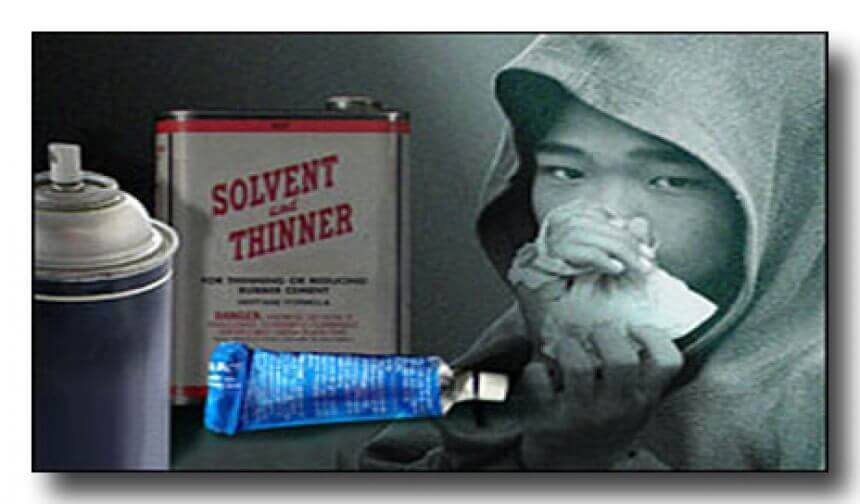
Scientific Name:
The term “inhalants” refers to a group of products that produce fumes or vapours that can lead to intoxication when inhaled.
Other Common Names:
Chroming, Sniffing, Huffing, Volatile Substance Use (VSU), Solvent Use, Intoxicative Inhalants.
Description:
There are a variety of inhalants that produce volatile vapours which affect the brain if inhaled. The chemicals are considered depressant drugs. They include solvents, spray paints, glues, cleaning fluids, and many others. Fumes or vapours are often inhaled directly from cans, bottles, tubes, or other packages. The fumes or vapours contain chemicals that are poisonous to humans if consumed. Typical chemicals found in various products include:
- Aerosols – butane, propane, fluorocarbons
- Cleaning agents – tetrachloroethylene, trichloroethane, trichloroethylene
- Solvents – acetone, methanol, toluene, methylene chloride, butane,
- isopropane, bromochlorodifluoromethane
- Anaesthetics – nitrous oxide, ethyl chloride, halothane, enflurane
- Food Products – nitrous oxide
- Nitrate Room Odorisers – amyl nitrite, (iso) propyl nitrite, (iso) butyl nitrate

The chemicals are extremely dangerous to humans when inhaled directly and have many of the same effects as illicit drugs. Though inhalants are primarily used by teenagers, they are also used by adults who consume illicit drugs and need a quick “fix” when unable to access drugs of choice.
Even a single use can cause significant health issues. They are depressant drugs that slow down brain and nervous system activity. They can also lead to a slowdown in breathing and heart rate.
Source:
Most inhalants are common products used in homes and businesses. Examples include the following:
- Glue
- Paint and spray paints
- Aerosol sprays
- Petrol
- Whipping cream (nitrous oxide)
- Gas bulbs (nitrous oxide)
- Cigarette lighter refills (butane gas)
- Liquid paper
- Spray cleaners
Forms:
Inhalants are fumes or vapours. There are different methods used to consume the chemicals:
- Directly from bottle, can, or container
- Contents poured on cloth and cloth is held over nose
- Contents sprayed directly into mouth or nose
- Health Effects:
- Psychological Effects:
Inhalants work within five minutes and quickly make a person feel light-headed. Some people feel euphoria, while others may experience agitation and anxiety. When chemicals are repeatedly sniffed or huffed, the drug user may experience hallucinations. Long-term use of inhalants will often have memory problems, mental confusion, mood swings, and feelings of paranoia.
Physical Effects:
- Acute – There are many possible effects associated with inhalant use. They include coughing, runny nose, nausea, diarrhoea, headaches, skin irritations around the mouth, and bloodshot eyes. The person may act like someone who has been drinking - experiencing dizziness, slurred speech and lack of coordination. Nitrites cause systemic vasodilation, increased heart rate, and a brief sensation of excitement and heat.
- Long-term – Continued use of inhalants can lead to weight loss, muscles weakness and muscle spasms, and fatigue. It is important to understand that even a single use can cause permanent damage to the body, like permanent motor impairment. If the person sprays a chemical directly into their mouth, the chemicals can burn or freeze the throat and paralyse airways, leading to suffocation. Most deaths due to inhalant use are due to using butane gas and aerosols. The chemicals can cause heart failure when the user does heavy exercise or experiences a lot of stress around the time of inhalant use. These are called “sudden sniffing deaths.”
Detection Period:
There are no drug tests for inhalants. However, an adult using inhalants to get high is more likely to be using illicit drugs.
Legal Status:
It is not illegal to use inhalants in any Australian territory or state. However, some states have passed laws concerning inhalants. In Western Australia, the Protective Custody Act 2000 allows the police to place an intoxicated person into protective custody until a responsible person is found. If the person is under-age, a parent or guardian is located. The Police are allowed to confiscate intoxicating substances from underage people.
Section 206 of the Western Australia Criminal Code 1913 makes it illegal to sell or supply inhalants when it is reasonable to expect they will be abused as intoxicants. The penalty is up to 12 months in prison and a fine of up to $12,000. There are also by-laws in some Aboriginal communities in Western Australia addressing the use, possession and supply of volatile substances.
Other Information:
Sometimes, inhalants are mixed with other drugs which can enhance the negative effects. For example, nitrates mixed with alcohol can lead to dangerously low blood pressure because both have blood-vessel relaxant properties.
